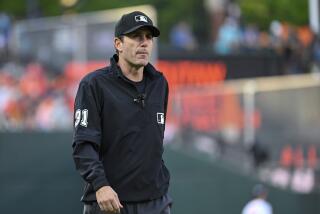One Umpire Grades Another: A for Garcia
- Share via
Doug Harvey umpired in the National League for 31 years before retiring in 1992, working more than 4,000 consecutive games from 1962 to 1988, and now lives near Porterville, Calif. Throughout the World Series, he will provide analysis and insight into the umpires’ decision-making behind the plate and on the bases.
I give home plate umpire Richie Garcia an A for Game One of the World Series. Through the entire ballgame, I saw two pitches that I might have possibly disagreed with--one in the fourth inning that was called a strike and the 2-2 pitch to Tino Martinez in the seventh.
Of course, that’s the pitch that everybody was griping about. I hate to say it, but that’s the one that rears its ugly head.
And if you went out there and you measured it with the finest instruments in the world, you’d find out that pitch was in that gray zone between a ball and a strike. It’s in that zone because the difference in an umpire’s eye between ball and strike is a fine pencil lead mark. And that son of a gun, that’s where it was--it’s in one of those gray zones.
And for some reason--it’s the bane of the Irish, it’s the luck of the umpire--you always seem to get a pitch like that with bases stacked. I guarantee you, the next one’s at least going off the wall someplace. It always seems to happen.
That same pitch--if it’s a tied ballgame and nobody’s on base--everybody says, “Aw, c’mon, get the ball up. Oh, hey, it’s a little low.” And they move on. But because of the situation, it suddenly becomes a big, big pitch.
The Padres changed pitchers after Martinez’s home run, so I decided to switch channels for a moment. Within one minute, a reporter for ESPN is saying, “Well, I’ll tell you one thing, the Padres have got plenty to complain about. The pitch was exactly down the middle of the plate--and it was called a ball.”
Well, it did have plenty of plate. There’s no argument there. The crucial thing was the height. I’m sure he called it low. I can’t say he missed the pitch. You can’t, because it’s an easy pitch to call a ball right there. It just so happens it’s a time of the game when everyone’s hanging on by their teeth and trying to win and it becomes a very important pitch.
There’s nothing an umpire can do about that. Those kind of pitches just seem to strike every once and a while.
Richie has one of the great American League strike zones. There’s a difference, because some of the umpires in the American League were raised wearing the outside protector, which affects how you call the bottom part of the strike zone. There used to be a difference of eight inches between the two leagues because of the outside protector.
Now the American League has gotten its umpires into the inside protector and is working to get them to calling strikes at the same height as the National League umpires.
You saw where the home run pitch to Tino was. My goodness, it was at the belt.
But that was a hell of a job behind the plate by Richie Garcia. If you can say, “I thought you had two pitches that I might have been called differently,” that’s a hell of a plate job. His percentage of calls, if they throw 300 pitches, was .990-something. That’s so close so close to being 1.000 percent correct, he just had one hell of a night.
And as it goes in the life of an umpire, he got stung by the one stupid pitch.
More to Read
Go beyond the scoreboard
Get the latest on L.A.'s teams in the daily Sports Report newsletter.
You may occasionally receive promotional content from the Los Angeles Times.










